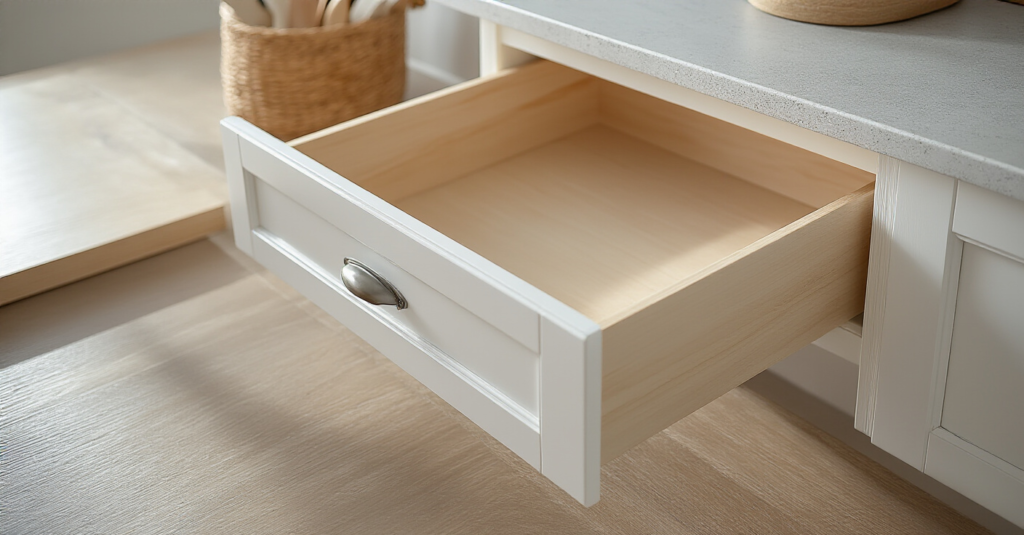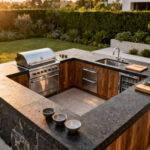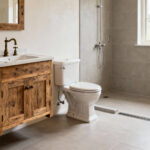Picture this: The big game is on. You’ve got the 85-inch screen dialed in, the surround sound is thumping, and the vibes are immaculate. So why is every single one of your guests crammed into your kitchen, standing shoulder-to-shoulder like they’re waiting for a train? Because that’s where the action is. The kitchen has become the new living room, the command center for every social event. And most of our kitchens are terribly, terribly designed for it.
Let’s get one thing straight: This isn’t about creating some sterile, lifeless, “Pinterest-perfect” space that’s afraid of a red wine spill. This is about engineering your kitchen for what it really is: the heart of your social life. It’s about flow. It’s about making it effortless for people to grab a drink, find a snack, and get back to the conversation without creating a 10-person traffic jam around the fridge.
The BS everyone tells you is that kitchen organization is about finding the right tiny bin for your paprika. The truth? It’s about designing a space that makes you a better, less-stressed host. It’s about creating an environment that encourages connection. So forget the glossy magazine spreads. Here are 20 real-world hacks to turn your kitchen into the ultimate, chaos-free social hub.
Phase 1: Foundations & Planning Your Perfect Space
Alright, before you buy a single cool organizer, you have to lay the groundwork. This is the strategic planning phase. Think of it like setting up the sound system before the band arrives. Getting this right means everything else will just work, making you look like an effortless hosting genius.
1. Declutter Ruthlessly: Purge Unused Items to Create Instant Space
Can we talk about the real reason to declutter? It’s not about “sparking joy”—it’s about getting useless junk out of the way before your guests arrive. That bread maker you used twice? The 17 chipped mugs you keep “just in case”? They are the enemy of good hosting. They’re obstacles in a high-traffic zone. When someone is trying to find a plate, they don’t need to excavate three layers of promotional glassware to get to it.
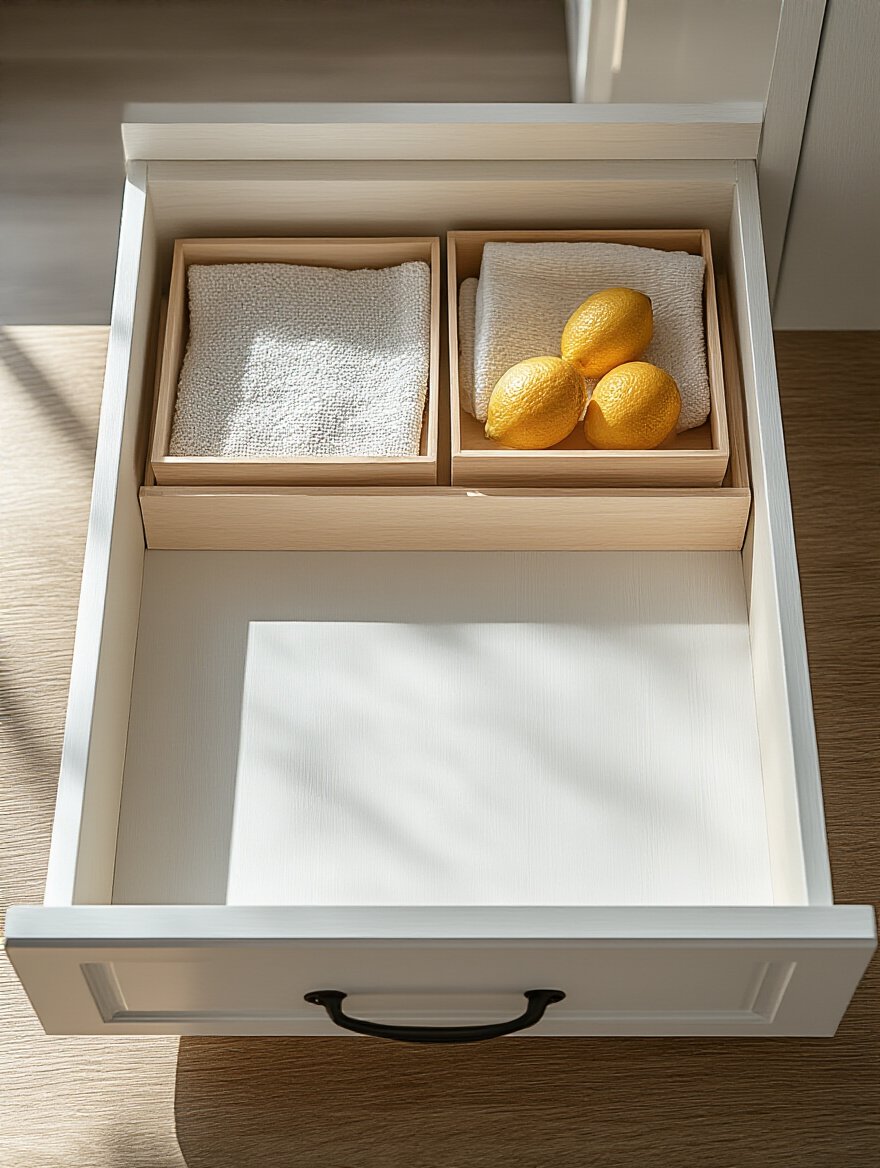
I once worked with a client whose massive kitchen island—the natural gathering spot—was so covered in clutter that guests just dumped their coats and purses on top, killing the entire social flow of the room. We got rid of 40% of the stuff in their kitchen that they hadn’t touched in a year, and suddenly, the island became a functional, beautiful centerpiece for drinks and appetizers. So be brutal. If it’s not serving you or your guests, it’s just getting in the way.
2. Map Your Kitchen Zones: Group Like Items for Enhanced Workflow Efficiency
Forget the old-school “work triangle” of the sink, stove, and fridge. When you’re a host, you need to think in terms of social zones. Your primary goal is to keep guests out of your active workspace while still making them feel welcome. You need a “Guest Zone” and a “Host Zone.” The Guest Zone is for self-service: drinks, ice, bottle openers, glasses, snacks. Set it up on the outer edge of your kitchen, maybe a peninsula or a counter away from the stove.
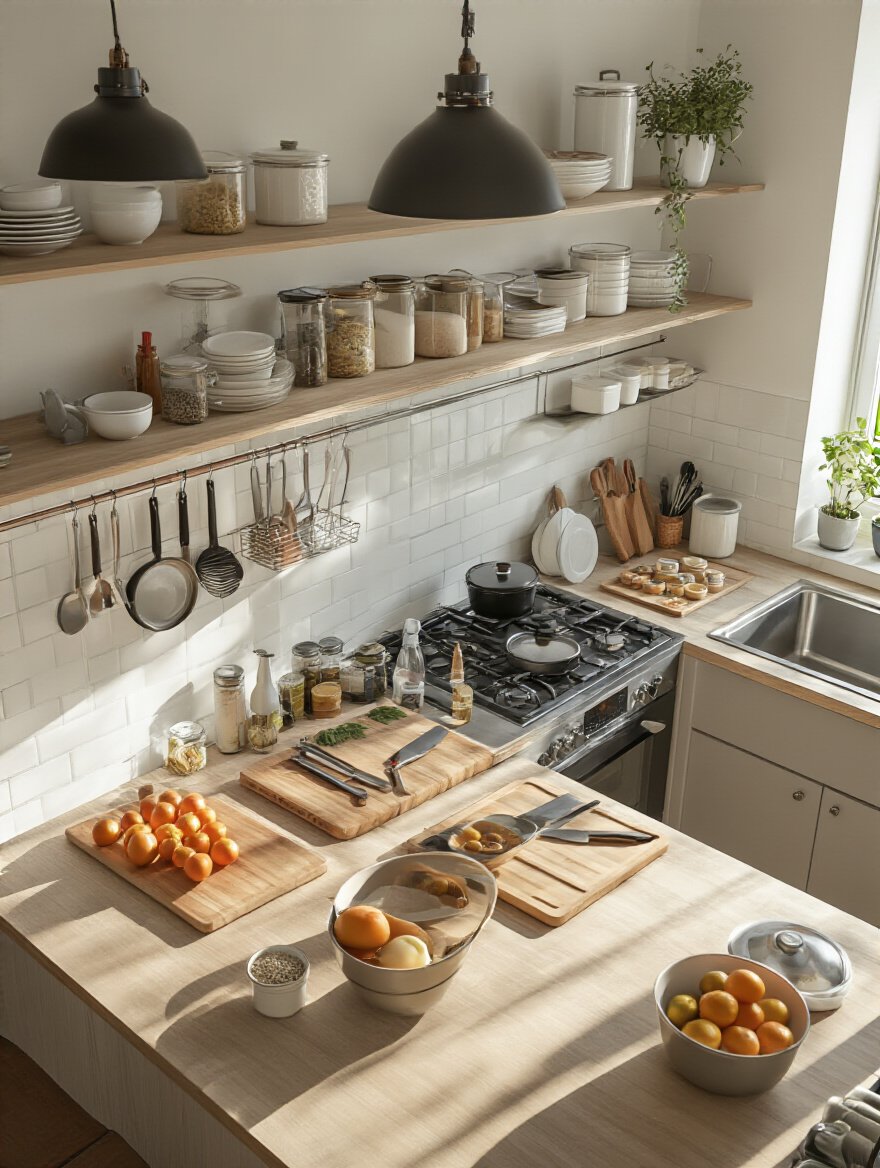
The Host Zone is your cockpit—the area where you’re plating food, pulling things from the oven, and dealing with hot pans. The two should barely overlap. I learned this the hard way when I threw a party and spent half the night saying “excuse me, hot stuff coming through!” as I tried to navigate through my own friends. By creating clear zones, you give your guests a dedicated space to hang out and help themselves, while you get the freedom to actually cook and manage the party without tripping over anyone.
3. Accurate Measurement is Key: Size Up Cabinets Before Buying Organizers
This is the boring part, I know. But you absolutely have to measure your spaces before you click “buy now” on that fancy drawer organizer. There is nothing more soul-crushing than waiting a week for your cool new pull-out shelf, only to find it won’t clear the cabinet hinges by a quarter of an inch. You’ll just throw it in the garage to die with your other failed projects.
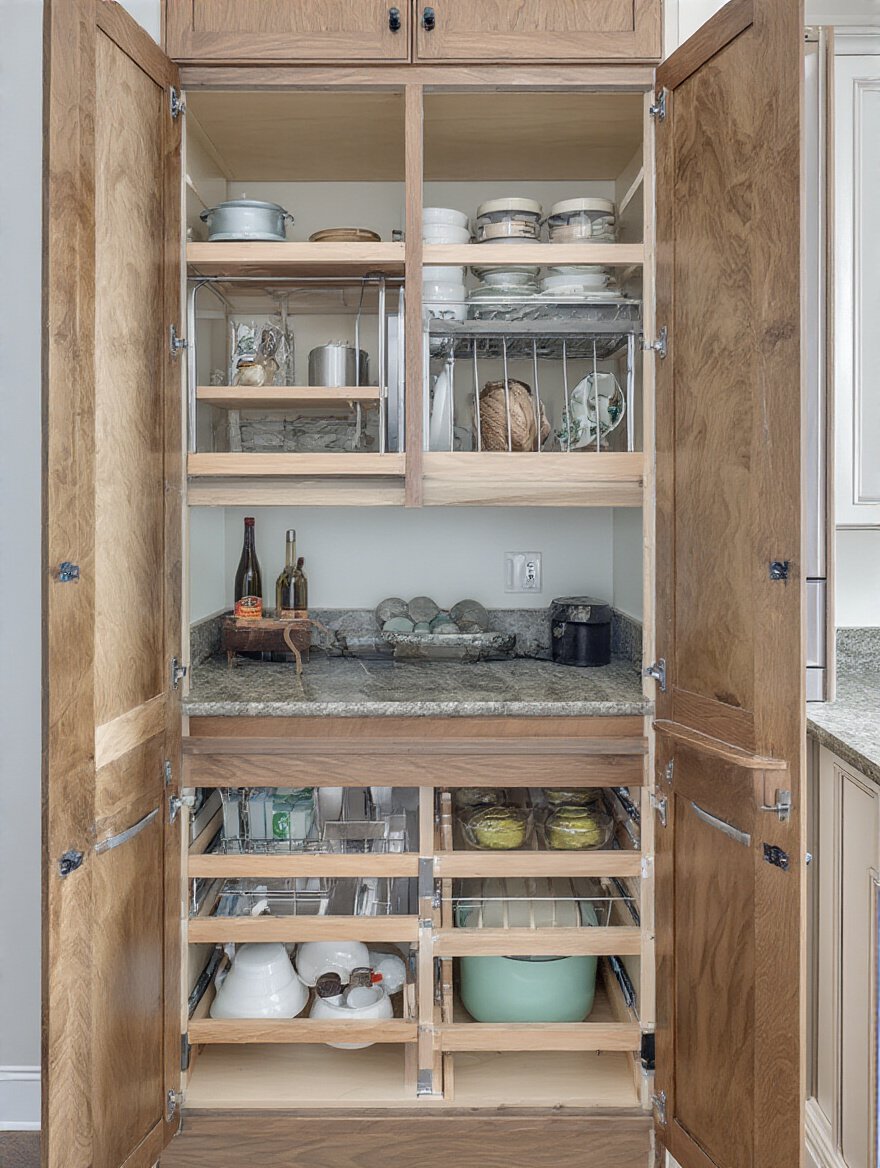
Here’s my shortcut: After you measure, use painter’s tape to outline the footprint of the organizer you want to buy inside the cabinet or drawer. This gives you a real-world visual of how it will fit. Will the door still close? Can you still reach around it? It takes five extra minutes and will save you hours of frustration and return-shipping headaches. Do it once, do it right.
4. Utilize Underutilized Spots: Identify Hidden Storage Opportunities in Your Layout
Every kitchen has weird, dead spaces that are just begging to be used. The gap next to the fridge, the space above your cabinets, and my personal favorite: the toe-kick area. That four-inch-high strip under your base cabinets? It’s not just for stubbing your toes. You can have custom drawers installed there, and it is the perfect hidden spot for the stuff you only use when hosting.
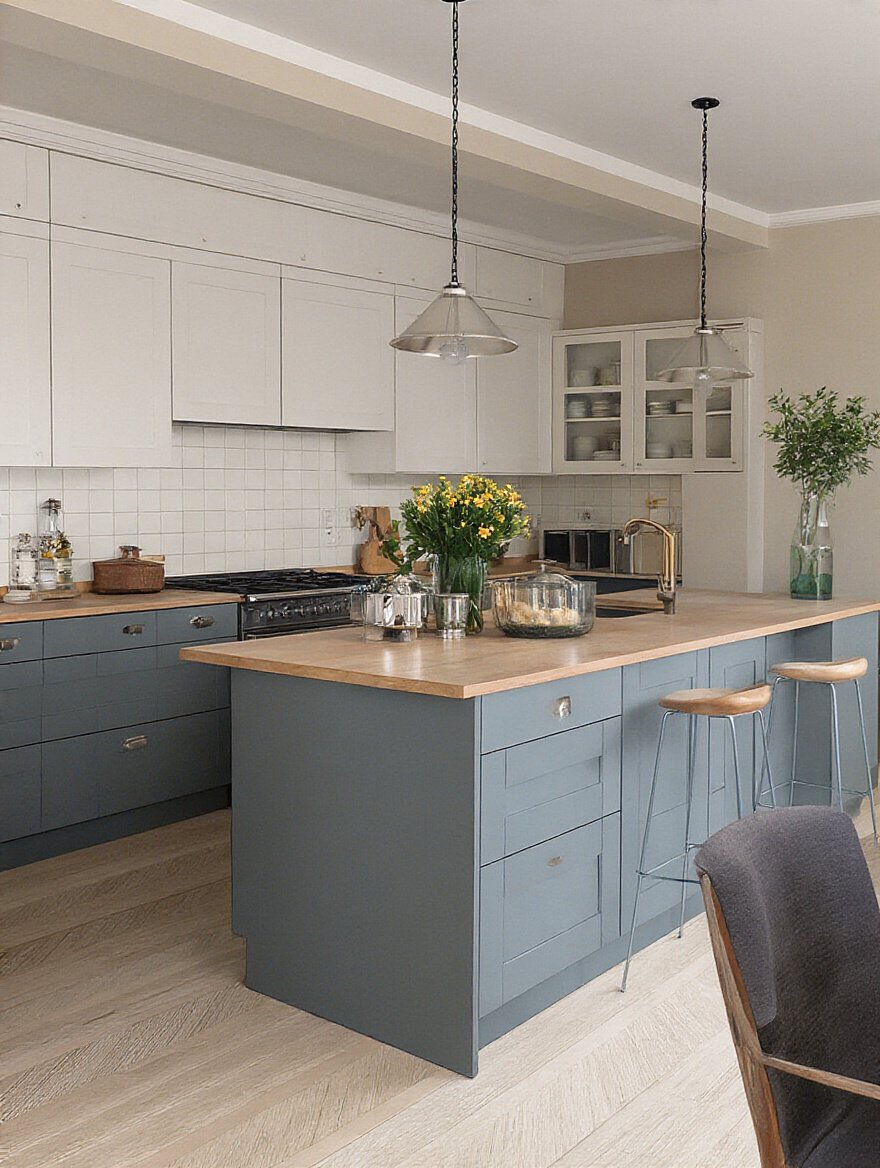
Think about it. Where do you put your giant serving platters, your holiday-themed cookie sheets, or that massive punch bowl? These things are bulky and used maybe three times a year. A toe-kick drawer is a genius, out-of-the-way spot to stash them. It’s secret storage that frees up your prime real estate cabinets for the stuff you actually use every day.
5. Optimize Pantry Layout: Strategically Plan Shelving Based on Item Frequency
Your pantry needs to be intuitive, not just for you, but for the friend you ask to “grab the big bag of tortilla chips.” When they open the door, it should be obvious. Prime real estate—the shelves at eye level—is for the daily stuff and the party stuff. Cereals, coffee, pasta, sure. But also create a designated, clearly labeled “Snacks” or “Party Supplies” zone.

Use clear bins so people can see what’s inside without digging. Put the heavy bulk items, like extra sodas or seltzer, on the bottom shelves. Put the rarely-used specialty flours on the top shelf. This isn’t just about your personal convenience; it’s about making your kitchen “user-friendly” for everyone. A well-organized pantry means your helpful guests can actually help, instead of just standing there looking confused.
Now that you’ve done the strategic recon, it’s time to install the gear that turns your cabinets and drawers from chaotic junk pits into high-performance storage machines.
Phase 2: Maximizing Cabinet & Drawer Potential
This is where the magic happens. We’re turning those dark, scary cabinets and bottomless drawers into models of efficiency. These are the upgrades that give you that “whoa, that’s smart” feeling every time you open a door, especially when you’re in the middle of hosting.
6. Conquer Deep Cabinets: Install Pull-Out Drawers for Instant Access to Items
Lower cabinets are black holes where Tupperware lids and forgotten appliances go to die. The only way to conquer them is with pull-out drawers. They are a complete game-changer, especially for hosting. Think about that huge, heavy serving platter you need that’s somehow always at the very back of the cabinet. Without a pull-out, you have to get on your hands and knees and unload a dozen other things just to get to it.
With a roll-out shelf, the entire contents of the cabinet glide out to meet you. It’s glorious. You can see everything, grab what you need, and slide it back in. No more deep-cabinet archeology while your guests are waiting for dip. It’s probably the single biggest quality-of-life upgrade you can make to an existing kitchen.
7. Master Corner Space: Deploy lazy Susans for 360-Degree Storage Efficiency
Corner cabinets are the Bermuda Triangle of the kitchen. But a good Lazy Susan or one of those fancy pull-and-pivot systems can reclaim almost 100% of that awkward space. My favorite way to use this for entertaining is to create a dedicated “Cocktail Corner.”

Instead of having bottles of liquor, mixers, and bitters scattered across your kitchen, consolidate them all onto a two-tiered Lazy Susan in that corner cabinet. One spin, and you have access to everything you need to make a drink. It keeps your countertops clear and makes for a cool “reveal” when a guest asks what you’ve got. It turns a frustrating dead zone into an efficient, self-contained bar.
8. Vertical Pan Storage: Use In-Cabinet Dividers for Tidy Baking Sheets
Stop stacking your baking sheets, cutting boards, and serving platters. That noisy, clattering avalanche every time you try to pull one out from the bottom is pure stress you don’t need. Instead, install simple wire or wood dividers to store everything vertically, like files in a filing cabinet.
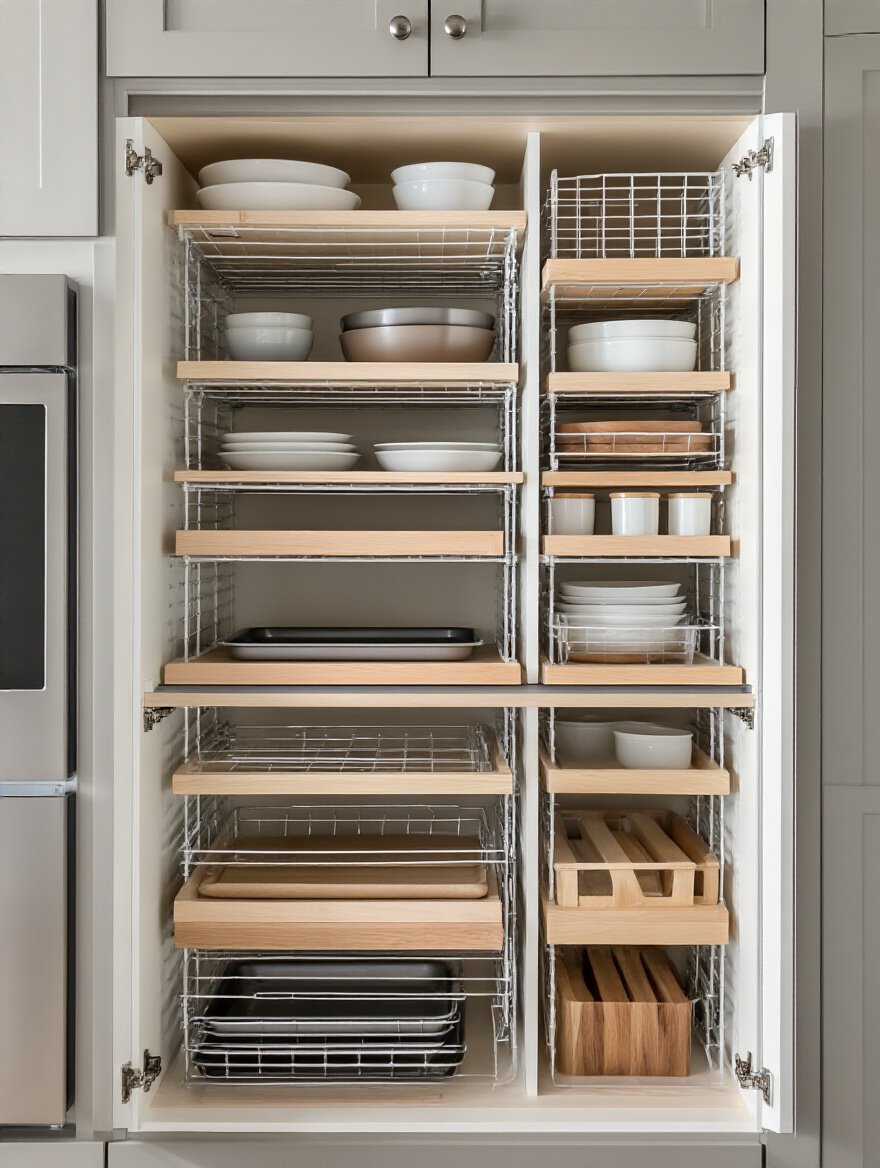
This is a non-negotiable hack for hosts. It means you can grab that beautiful slate charcuterie board or the big pizza stone in two seconds, with one hand, without causing a ruckus. It looks cleaner, it’s better for your bakeware, and it makes you feel like a pro who has their act together.
9. Tame the Junk Drawer: Implement Expandable Dividers for Small Item Order
Every kitchen has one, but let’s rebrand it. It’s no longer the “junk drawer”; it’s the “Host’s Utility Drawer.” This is command central for social gatherings. Use expandable bamboo dividers to create custom-sized compartments for the essentials.
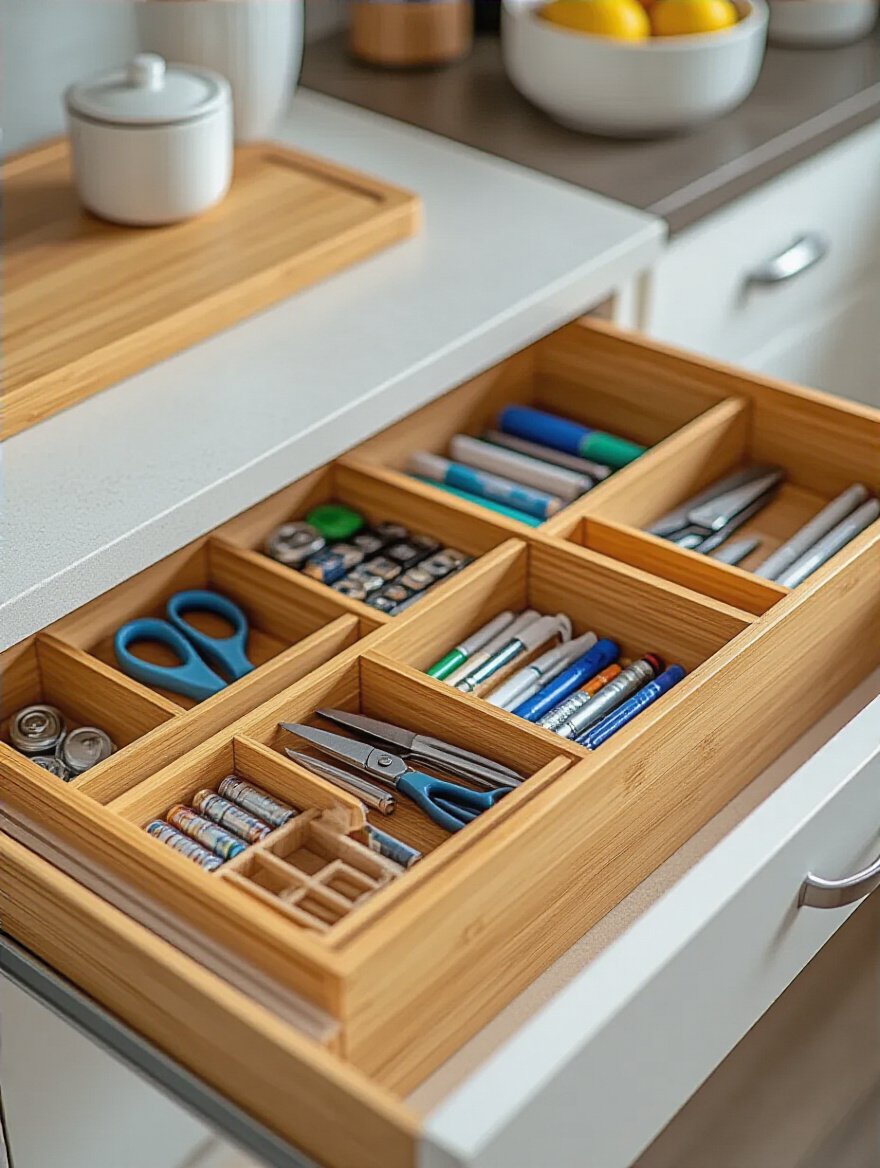
You need a spot for a bottle opener, a corkscrew, wine stoppers, birthday candles, a lighter, tape, scissors, and Sharpies for labeling cups. When you need one of these things in a pinch, you need it now. Organizing this one drawer will make you feel like the most prepared host on the planet.
10. Elevate Pantry Visibility: Use Stackable Shelf Risers for Tiered Food Storage
Shelf risers are one of the cheapest and most effective hacks out there. They’re basically little tables you put on your shelves to create tiered, stadium-style seating for your canned goods and jars. No more wondering if you have another can of black beans hidden behind the tomato paste.
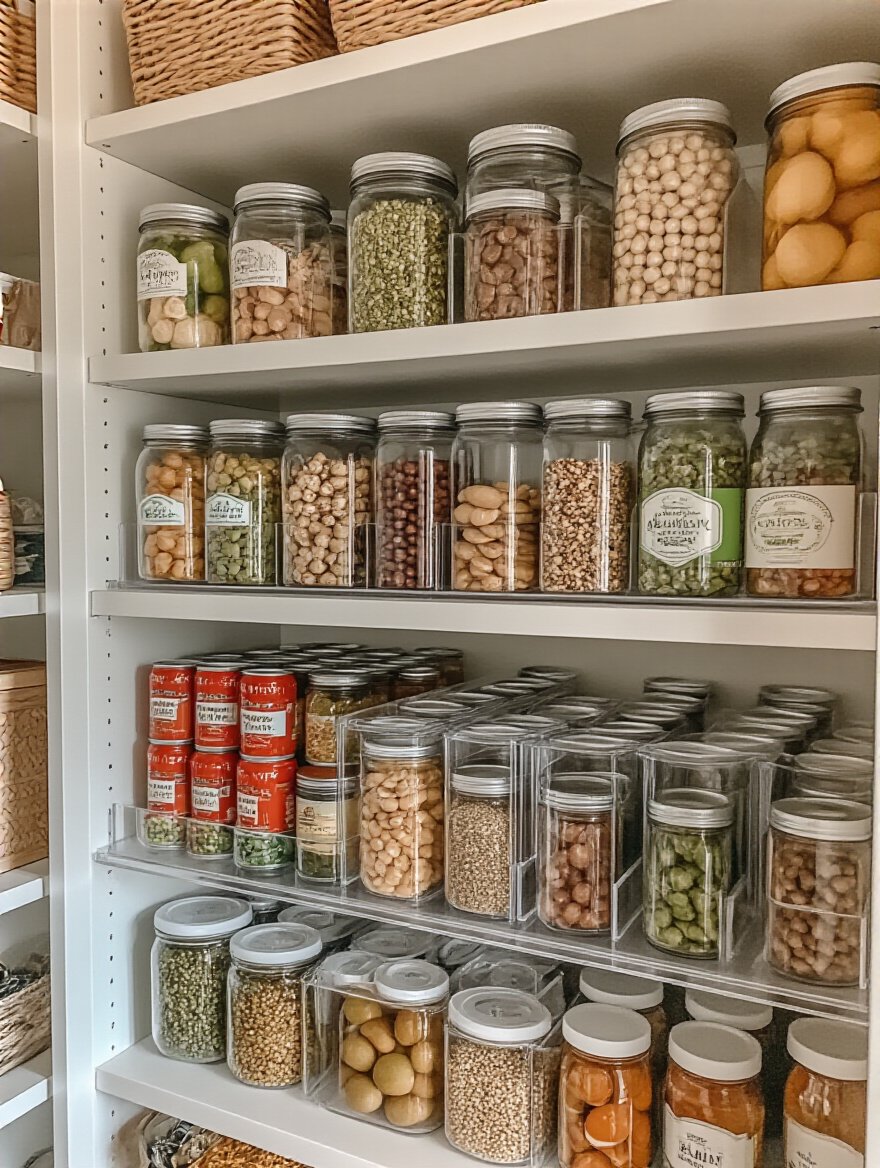
For entertaining, this is brilliant for setting up a self-serve station. Use risers on a counter or in your pantry to display different dips, condiments, or small bowls of toppings for a taco bar. It creates an impressive, professional-looking spread and makes it easier for guests to see all their options.
11. Organize Under the Sink: Utilize Sliding Baskets for Cleaning Supplies Access
The under-sink cabinet needs to be your “Emergency Spill Response” unit. When a guest knocks over a glass of red wine on your new rug, you don’t have time to go searching for the Folex. That space should contain only cleaning supplies, and they need to be instantly accessible.
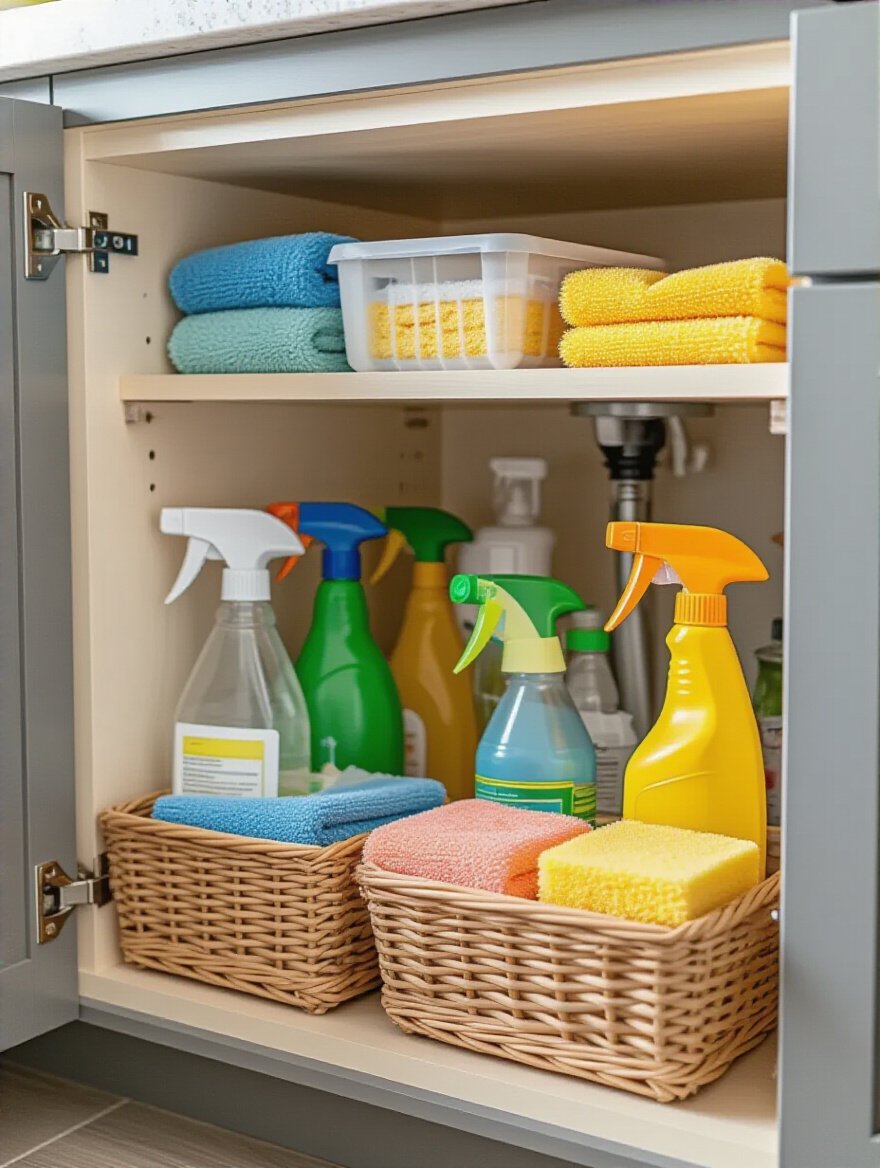
A two-tiered sliding basket organizer is perfect for this. Top basket: sponges, scrubbers, gloves. Bottom basket: spray bottles and cleaners. You pull it out, grab what you need, and handle the crisis in seconds. It’s a system that brings order to chaos, right when you need it most.
Now that your main storage is dialed in, let’s get into the high-tech, specialized gear that will take your kitchen’s functionality to the next level.
Phase 3: Smart Solutions & Product Integration
Alright, this is where we get into the cool gear and clever product integrations. It’s about leveraging smart design to solve specific, annoying kitchen problems. Think of these as the apps and plug-ins for your kitchen’s operating system.
12. Maximize Cabinet Doors: Install Over-the-Door Racks for Lids or Wraps
The inside of your cabinet doors is prime, untapped real estate. A simple rack mounted on the door is the perfect home for those awkward items that clutter up drawers. I’m talking about the rolls of plastic wrap, foil, and parchment paper, or the eternal nemesis of kitchen organization: pot lids.

My client had a whole drawer dedicated to a jumbled mess of pot lids. We installed two simple lid racks on the inside of a cabinet door and instantly freed up an entire drawer for other things. It’s a simple, cheap fix that clears out so much clutter and keeps the things you need for cooking or wrapping leftovers right at your fingertips.
13. Wall-Mounted Storage: Use Magnetic Strips for Knives or Wall Caddies for Spices
Getting stuff up off the counter and onto the walls is key to creating a clean, functional workspace. A magnetic knife strip is the number one way to do this. It looks badass, it keeps your blades from getting dulled in a drawer, and most importantly for hosting, it keeps sharp objects up and away from curious little hands.

Wall-mounted caddies are also fantastic for a “theme” station. Install a few small shelves near your coffee maker for mugs, sugar, and pods. Or put a spice rack right next to your stove so you can grab what you need in the heat of the moment without opening a single cabinet. It’s all about reducing friction and making the act of cooking smoother.
14. Add a Rolling Cart: Gain Flexible Storage for Appliances or Bulk Goods
A rolling cart is the single most versatile piece of furniture you can add to your kitchen. It is the ultimate hosting multitool. For one party, it can be a mobile bar, stocked with spirits, ice, and glassware. For the next, it’s a dessert and coffee station that you can wheel out after dinner. On a normal day, it can be an “appliance garage” for your stand mixer or air fryer, keeping them off your main counters.

Find a sturdy one with locking wheels—stainless steel or butcher block tops are fantastic. It gives you an extra work surface and extra storage that can move wherever the party does. When you’re not entertaining, you can just tuck it away. It’s a flexible solution for a dynamic space.
15. Over-Cabinet Storage: Hang Hooks for Towels or Dishcloths Without Drilling
This is a small hack, but it’s a good one, especially for renters. Instead of draping a damp dish towel over your faucet or leaving it in a sad pile on the counter, use a simple over-the-cabinet hook. It gives the towel a place to live and allows it to dry properly, which is just more hygienic.
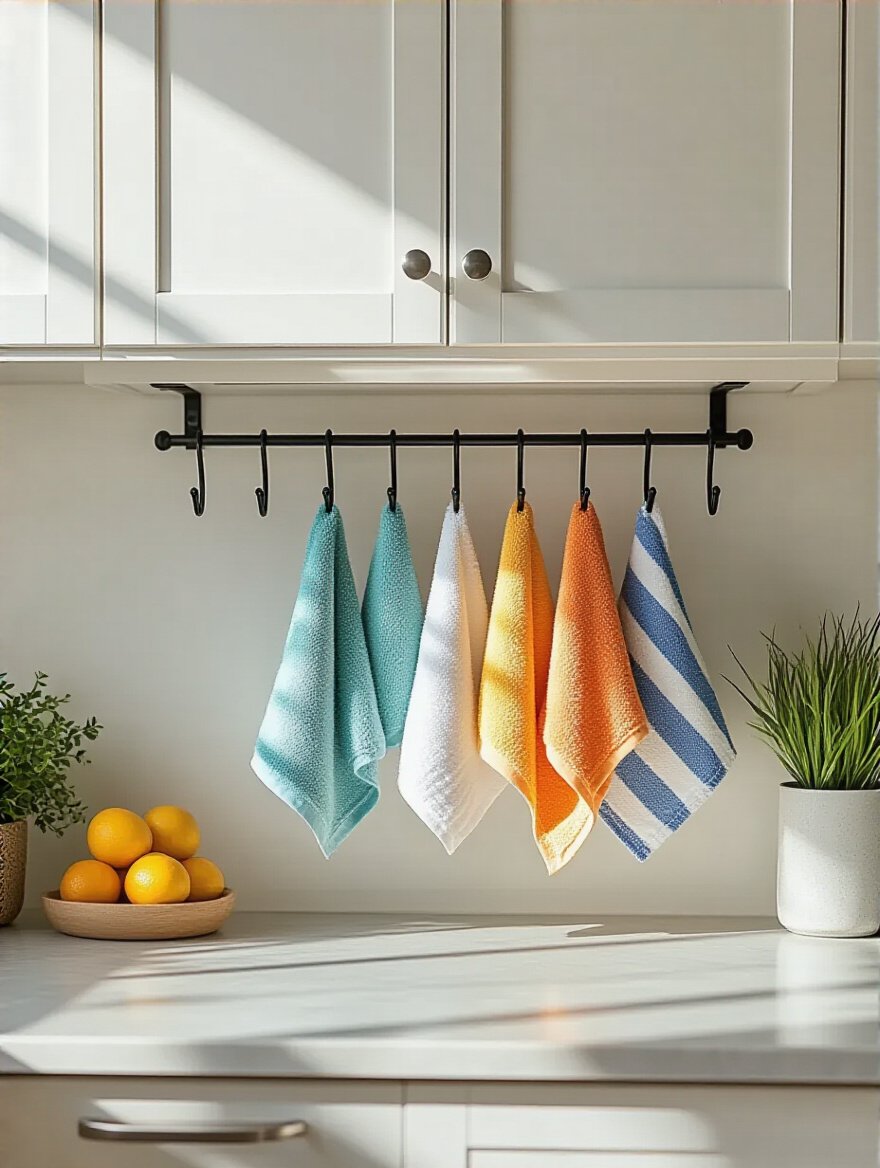
For hosts, it’s a great way to signal “this is the clean hand towel” versus “this is the one I use for mopping up spills.” Having a dedicated, clean, dry towel available for guests is one of those small touches that shows you’re a thoughtful host.
16. In-Drawer Knife Block: Securely Store Knives While Protecting Blades
If a magnetic strip on the wall isn’t your style, an in-drawer knife block is the next best thing. Tossing expensive knives into a drawer with a bunch of other metal utensils is a cardinal sin—it’s dangerous for your fingers and disastrous for your blades. A dedicated block keeps them sharp, secure, and organized.
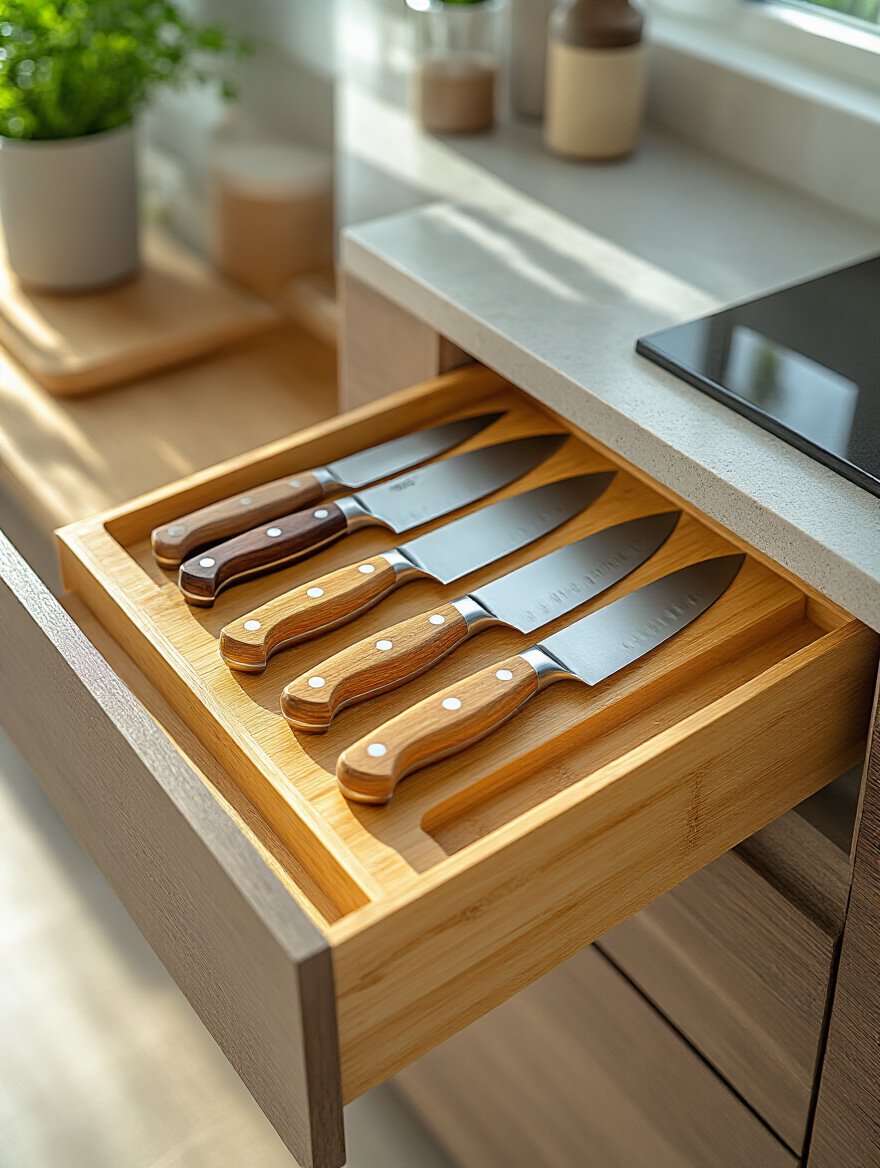
This is a huge safety upgrade for any home, but especially one where you have guests (and potentially kids) opening drawers. It prevents accidents and keeps your most important tools in prime condition. Plus, getting that clunky knife block off your counter frees up a surprising amount of precious prep space.
You’ve got the gear. You’ve got the setup. But now for the hardest part: keeping it that way. Let’s talk about the long-term strategies to keep your kitchen from backsliding into a clutter catastrophe.
Phase 4: Advanced Strategies & Maintaining Lasting Order
An organized kitchen is not a destination; it’s a practice. You can have the best systems in the world, but they’re useless if you don’t maintain them. This is about building simple habits that ensure your kitchen stays a high-functioning, stress-free zone, always ready for the next impromptu get-together.
17. Implement FIFO System: Rotate Pantry Items to Reduce Food Waste Annually
FIFO stands for “First-In, First-Out,” a principle from the logistics world that is brilliant for your pantry. It just means you use the old stuff before the new stuff. When you buy a new can of beans, you put it at the back of the line, behind the one you already have. This simple rotation prevents you from discovering a can of something from 2018 in the depths of your pantry.

For hosts who love to stock up on fancy crackers, cheeses, or other perishable goods, this is crucial. It saves you money and reduces food waste. Create a small, designated “Use First!” bin in your fridge or pantry for items that are nearing their expiration date. It’s a smart system that makes your inventory work for you.
18. Label Everything Clearly: Ensure Family Members Easily Find and Return Items
If you live with other people, a label maker is not a suggestion, it is a requirement for domestic harmony. You can create the most logical, beautiful organizational system, but if your partner or kids can’t figure it out in two seconds, they’re just going to shove things wherever they fit. Labeling is the instruction manual for your kitchen.
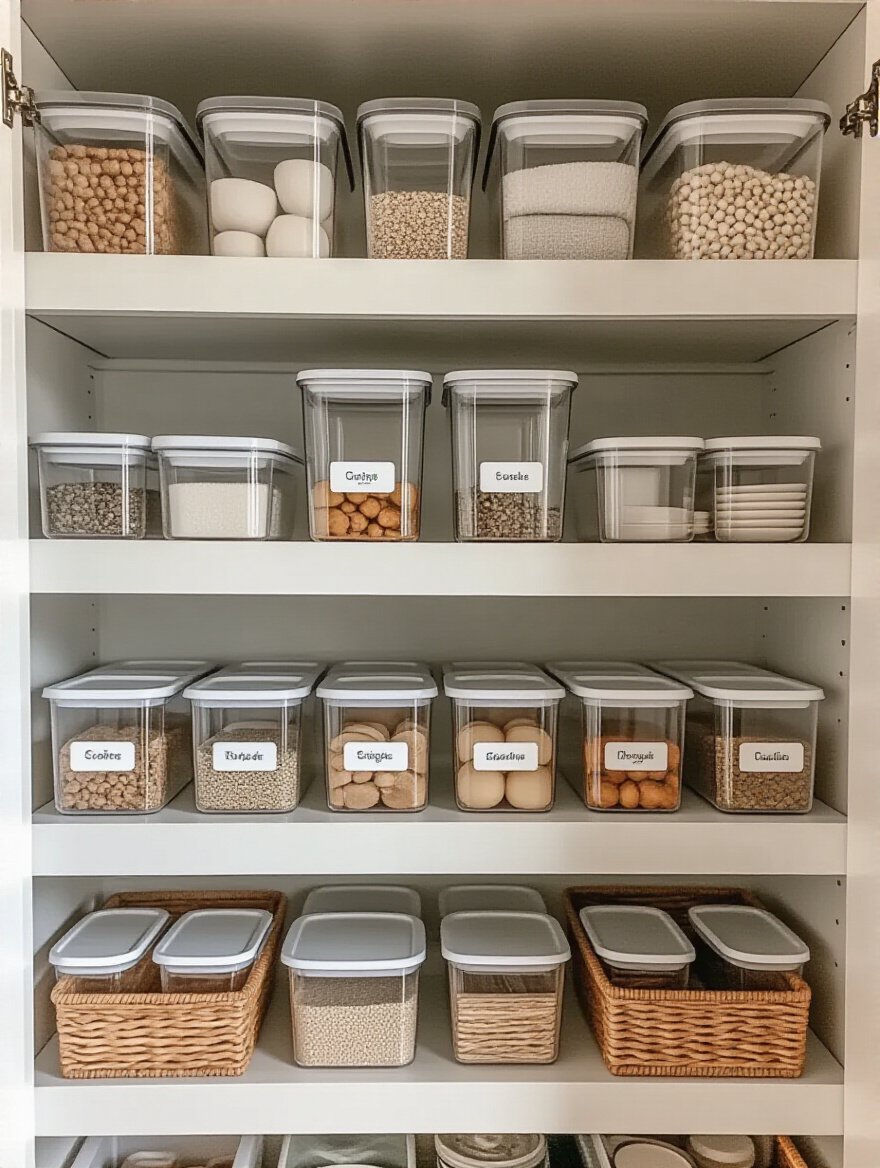
“Labeling is not about being controlling; it’s about being clear. Clarity eliminates confusion and friction.”
Use clear labels on bins in the pantry (“Snacks,” “Baking,” “Pasta”), on drawer dividers (“Utensils,” “Gadgets”), and especially on any containers you decant things into. When a guest is helping you clean up, they’ll know exactly where the plastic containers go. It’s a small thing that makes a massive difference in maintaining order long-term.
19. Create a Charging Station: Designate One Spot for All Electronic Devices
The modern-day clutter monster is the tangled mess of charging cables snaking across your counter. And the first question at any gathering is, “Hey, can I charge my phone?” Solve both problems at once by creating a dedicated, hidden charging station. The best spot is inside a drawer near an outlet.
Get a drawer organizer and a multi-port USB power strip. Drill a hole in the back of the drawer for the cord, and voilà. You have a hidden, clutter-free hub for phones, tablets, and smartwatches. It gets the electronic chaos off your beautiful countertops and gives your guests a single, obvious place to power up. It’s a simple, tech-savvy solution that enhances hospitality.
20. Schedule Quick Maintenance: Dedicate 15 Minutes Weekly to Prevent Re-Cluttering
All of this will fall apart if you don’t do maintenance. But it doesn’t have to be some monumental, hours-long task. My rule is the “15-Minute Weekly Reset.” Once a week—say, Sunday evening—set a timer for 15 minutes and just put everything back where it belongs.
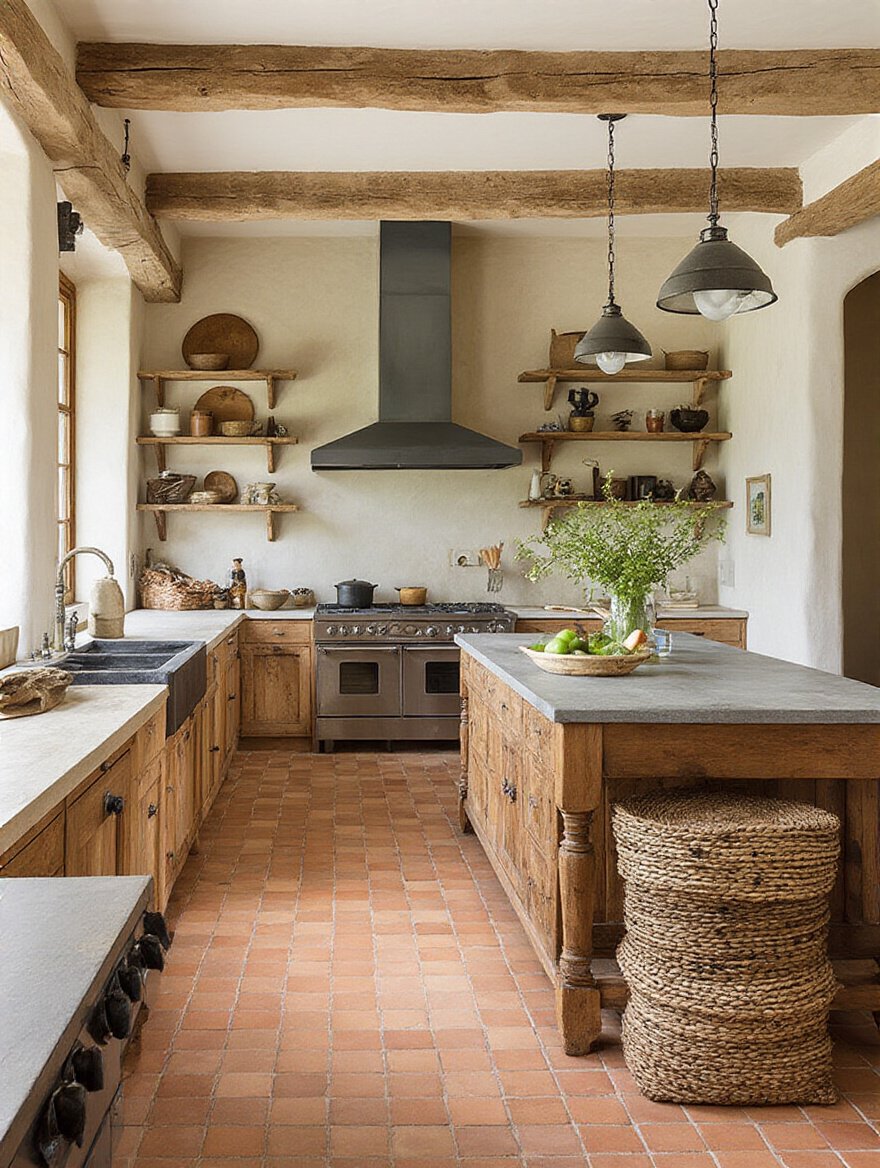
Wipe down the counters, put away the mail that’s accumulated, restock the snack bin, and put that one stray dish in the dishwasher. It’s not a deep clean; it’s a quick reset. That short, consistent burst of effort prevents clutter from ever building up to an overwhelming level and ensures your kitchen is always about 80% “guest-ready.”
Your Kitchen, Your Social Hub
Look, at the end of the day, a well-organized kitchen isn’t about impressing people with your perfectly aligned spice jars. It’s about making your life easier and making your home a more welcoming place for the people you love. It’s about removing the friction and stress from hosting so you can actually relax and enjoy your own party.
By thinking of your kitchen as a social space first and a cooking space second, you can design a system that truly serves you. It’s the engine of your social life. These hacks are the tune-up. They help it run smoother, faster, and more efficiently, so you can focus on what really matters: creating those moments and memories that happen when you bring great people together.
